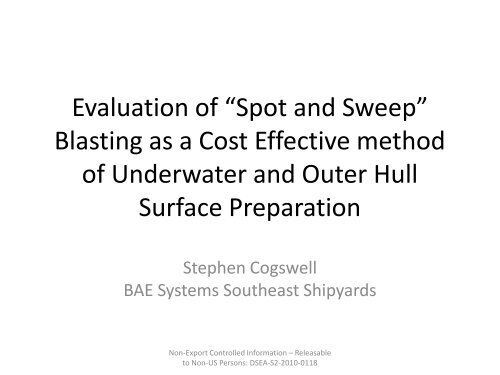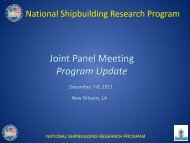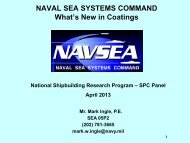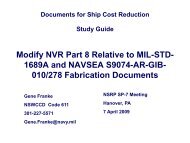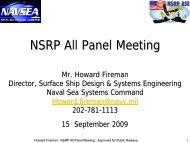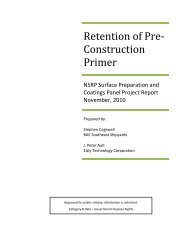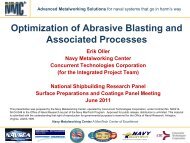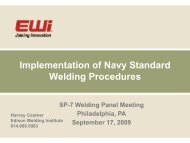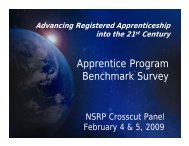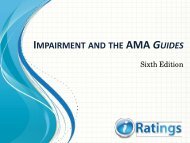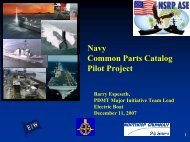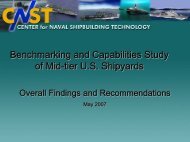Evaluation of âSpot and Sweepâ Blasting as a Cost Effective ... - NSRP
Evaluation of âSpot and Sweepâ Blasting as a Cost Effective ... - NSRP
Evaluation of âSpot and Sweepâ Blasting as a Cost Effective ... - NSRP
Create successful ePaper yourself
Turn your PDF publications into a flip-book with our unique Google optimized e-Paper software.
<strong>Evaluation</strong> <strong>of</strong> “Spot <strong>and</strong> Sweep”<strong>Bl<strong>as</strong>ting</strong> <strong>as</strong> a <strong>Cost</strong> <strong>Effective</strong> method<strong>of</strong> Underwater <strong>and</strong> Outer HullSurface PreparationStephen CogswellBAE Systems Southe<strong>as</strong>t ShipyardsNon-Export Controlled Information – Rele<strong>as</strong>ableto Non-US Persons: DSEA-S2-2010-0118
Spot <strong>and</strong> Sweep, in progressNon-Export Controlled Information – Rele<strong>as</strong>ableto Non-US Persons: DSEA-S2-2010-0118
Concept• Reduce Total Ownership <strong>Cost</strong> <strong>of</strong> cleaning <strong>and</strong>painting underwater hulls on US Navy ships byleaving in-tact anti-corrosive on the hullduring re-painting• This paper is a result <strong>of</strong> the work beingaccomplished by the <strong>NSRP</strong> SurfacePreparation <strong>and</strong> Coating Panel project team:Steve Cogswell, Pete Ault, Gordon Kuljian &John Odwazny.Non-Export Controlled Information – Rele<strong>as</strong>ableto Non-US Persons: DSEA-S2-2010-0118
Spot & Sweep to well adhered Epoxy½ & ½ , spot & sweep/fullremoval, edge check in progressSpot & Sweep, DFT in tact epoxy7 to 15 milsNon-Export Controlled Information – Rele<strong>as</strong>able toNon-US Persons: DSEA-S2-2010-0118
Spot & Sweep to well adhered EpoxySpot & Sweep, robotic headSpot & sweep, robotic headNon-Export Controlled Information – Rele<strong>as</strong>able toNon-US Persons: DSEA-S2-2010-0118
Project Goals• Demonstrate commercial technology on USNavy ships– Document performance issues– Identify process refinements– Determine life cycle cost impact• Develop NSI 009-32 language– Process requirements– Objective Quality Evidence (OQE)Non-Export Controlled Information – Rele<strong>as</strong>ableto Non-US Persons: DSEA-S2-2010-0118
Ph<strong>as</strong>e One, Commercial repair. 80K sqftaccomplished in 6 days, full removal prior toapplication <strong>of</strong> IntersleekFull coating removalFull coating removalNon-Export Controlled Information – Rele<strong>as</strong>able toNon-US Persons: DSEA-S2-2010-0118
“Commercial Ship”Full removal to bilge keelFull removal to keel blocksNon-Export Controlled Information – Rele<strong>as</strong>able toNon-US Persons: DSEA-S2-2010-0118
Adhesion testing over Spot <strong>and</strong> SweepArea w<strong>as</strong> prepared after spot <strong>and</strong> sweep for the dolly tome<strong>as</strong>ure any impact/fracturing from the UHPwaterbl<strong>as</strong>t2189 psi, no impactNon-Export Controlled Information – Rele<strong>as</strong>able toNon-US Persons: DSEA-S2-2010-0118
USS KLAKRING (FFG 42)• Demonstration in February, 2011– BAE Systems Southe<strong>as</strong>t Shipyards, Jacksonville FL– Existing coating applied in November, 2002– Performed on freeboard <strong>and</strong> underwater hull– Data collected• Production rates• Adhesion <strong>of</strong> coating before <strong>and</strong> after cleaning• Extent <strong>of</strong> coating removedNon-Export Controlled Information – Rele<strong>as</strong>ableto Non-US Persons: DSEA-S2-2010-0118
USS Klakring (FFG-42) Spot & SweepThe surfaceSpot <strong>and</strong> sweep to existing welladhered epoxy coatingNon-Export Controlled Information – Rele<strong>as</strong>able toNon-US Persons: DSEA-S2-2010-0118
Chariot RoboticsArticulating robotic head makinga turn.Vertical, cutting pathNon-Export Controlled Information – Rele<strong>as</strong>able toNon-US Persons: DSEA-S2-2010-0118
Flow Hydro Cat½ & ½, Chariot(left), Flow (right)Hydro Cat tracking verticallyNon-Export Controlled Information – Rele<strong>as</strong>able toNon-US Persons: DSEA-S2-2010-0118
Existing LSA >80 mils> 80 mils > 80 milsNon-Export Controlled Information – Rele<strong>as</strong>able toNon-US Persons: DSEA-S2-2010-0118
Adhesion values, Spot & Sweep2 coats AC – 1007 psi 1 coat AC- 1356 psiNon-Export Controlled Information – Rele<strong>as</strong>able toNon-US Persons: DSEA-S2-2010-0118
Adhesion Values, Spot & Sweep1 st <strong>and</strong> 2 nd AC, cut through 2030 psiNon-Export Controlled Information – Rele<strong>as</strong>able toNon-US Persons: DSEA-S2-2010-0118
Paint, in progressNon-Export Controlled Information – Rele<strong>as</strong>ableto Non-US Persons: DSEA-S2-2010-0118
Hull Plating from the Side shellretained for Laboratory testingNon-Export Controlled Information – Rele<strong>as</strong>ableto Non-US Persons: DSEA-S2-2010-0118
USS SHOUP (DDG-86)• Tentative demonstration- limited square footage– Todd Shipyards– August, 2011– Scope limited to underwater hull, (TBD)Tentative demonstration 100% Spot <strong>and</strong> Sweep onMSC vessel Gulf Co<strong>as</strong>tNon-Export Controlled Information – Rele<strong>as</strong>ableto Non-US Persons: DSEA-S2-2010-0118
Technical Issues to Overcome• “Crop Circles” create aesthetic concerns• Equipment which attaches with magnets maybe <strong>of</strong> concern to the Navy• Criteria for inspectors is subjective• OQE is limitedNon-Export Controlled Information – Rele<strong>as</strong>ableto Non-US Persons: DSEA-S2-2010-0118
Initial Inspection criteria <strong>and</strong> OQE3.7 Change the requirements <strong>of</strong> Column A (surface preparation) <strong>of</strong> Table One, Line 4 called out in 3.3 <strong>and</strong> accomplish alternativesurface preparation <strong>as</strong> follows:3.7.1 Remove all antifouling coating <strong>and</strong> remove approximately 1/2 <strong>of</strong> the thickness <strong>of</strong> the current epoxy tie coat thickness fromthe are<strong>as</strong> listed in 1.2.1 with the following exceptions: APU cavities <strong>and</strong> fairing plates, sea chests <strong>and</strong> hull openings up to valveflanges <strong>and</strong> sea chest strainers which will be prepared in accordance with 3.3.3.7.2 Smoothly feather or transition from are<strong>as</strong> <strong>of</strong> bare metal to the retained epoxy primer/tie coat in are<strong>as</strong> <strong>of</strong> sharp or "step"transition between bare metal <strong>and</strong> paint.3.7.3 Remove all rust <strong>and</strong> fouling from are<strong>as</strong> <strong>of</strong> bare metal to create a SSPC SP-12, WJ2M or WJ2L level <strong>of</strong> surface cleanliness inaccordance with 009-32, Change 1 <strong>of</strong> 2.1.3.7.4 Upon completion <strong>of</strong> the surface preparation <strong>of</strong> the are<strong>as</strong> listed in 3.7.1 apply one coat <strong>of</strong> antifouling primer, in accordancewith 009-32 <strong>of</strong> 2.1 including Table One, Line 4, Column B , Minimum DFT: 7-mils, Maximum DFT: 16-mils.4.2 There shall be no more than two colors <strong>of</strong> paint visible in any area <strong>of</strong> retained coating. Inspectors shall observe the red primeradjacent to any bare metal are<strong>as</strong> <strong>and</strong> then continue observations into the bulk <strong>of</strong> the retained epoxy. Dark gray epoxy may beretained on top <strong>of</strong> the red primer, but any visual evidence <strong>of</strong> additional coats <strong>of</strong> red or black paint on top <strong>of</strong> the gray shall be causefor closer inspection. Upon closer inspection, a solvent-wipe test with a white rag shall be conducted using the antifouling coatingclean-up solvent. If the solvent wipe test shows color transfer onto the rag, the area shall be rejected. Rejected are<strong>as</strong> shall becleaned again until no color transfers to the rag.4.3 There shall be no are<strong>as</strong> <strong>of</strong> sharp transition or steps between bare metal <strong>and</strong> paint. Any such are<strong>as</strong> shall be inspected <strong>and</strong>tested with a dull putty knife to determine adhesion. If the paint flakes or can be dislodged, the area shall be rejected <strong>and</strong> cleanedagain to remove the loose paint.Non-Export Controlled Information – Rele<strong>as</strong>ableto Non-US Persons: DSEA-S2-2010-0118
Draft Requirement• Draft requirement currently being developedfrom Lessons Learned during the Demo(s).• Shall be written in language ready for theSt<strong>and</strong>ard Item 009-32.Non-Export Controlled Information – Rele<strong>as</strong>ableto Non-US Persons: DSEA-S2-2010-0118
DRAFT- PROCESS FOR SPOT AND SWEEP BLAST DEMONSTRATION1. The spot <strong>and</strong> sweep process preformed by the Chariot Robotics unit (or equivalent) may beused for all are<strong>as</strong> <strong>of</strong> the underwater-hull <strong>and</strong> freeboard on approved surface ships. For are<strong>as</strong> notprepared using the Chariot Robotics or equivalent; Ultra High Pressure (UHP) lances, abr<strong>as</strong>ivebl<strong>as</strong>ting, may be used to create either an SSPC SP-12 WJ-2/M surface or an SSPC SP-10 surface.SSPC SP-3 Power tool cleaning may be authorized for fairing in the spot <strong>and</strong> sweep surface <strong>as</strong>required.2. The contractor shall inspect the existing coating on the hull <strong>and</strong> shall determine the sequence<strong>of</strong> the epoxy coatings currently on the hull prior to bl<strong>as</strong>ting. The anticipated sequence is redprimer followed by gray epoxy tie coat. The contractor shall note these colors for use inNAVSEA inspection <strong>of</strong> the hull prior to application <strong>of</strong> the first coat <strong>of</strong> epoxy primer.3. The Chariot Robotics unit (or equivalent) shall be set up to accomplish the following:(a) Remove all rust <strong>and</strong> fouling from are<strong>as</strong> <strong>of</strong> bare metal to create a SSPC SP-12, WJ-2/Msurface condition in accordance with specified NAVSEA St<strong>and</strong>ard Item 009-32, FY 12 Change 1processes.(b) Remove all antifouling coating <strong>and</strong> remove approximately 1/2 <strong>of</strong> the thickness <strong>of</strong> the currentepoxy tie coat thickness from the underwater hull area.(c) Remove all silicone alkyd, regardless <strong>of</strong> coating thickness, <strong>and</strong> remove approximately 1/2 <strong>of</strong>the thickness <strong>of</strong> the current epoxy topcoat from the freeboard area.(d) Smoothly feather or transition from are<strong>as</strong> <strong>of</strong> bare metal to the retained epoxy primer/tie coat.Are<strong>as</strong> <strong>of</strong> sharp or "step" transition between bare metal <strong>and</strong> paint shall be noted by the NAVSEArepresentative for detailed inspection. *under review: Feather edges where the Chariot Roboticsunit (or equivalent) leave behind markings in the existing paint (concentric circle are<strong>as</strong> whichsome describe <strong>as</strong> “crop circles”).
4. Upon completion <strong>of</strong> st<strong>and</strong>ard zones or work are<strong>as</strong>, in accordance with current, st<strong>and</strong>ardcontractual requirements, the contractor shall inform the NAVSEA representative when they areready to apply the first coat <strong>of</strong> primer to the zone or work area. NAVSEA representative shallconduct all st<strong>and</strong>ard data reviews <strong>and</strong> inspections on bare metal are<strong>as</strong> in accordance withspecified St<strong>and</strong>ard Item 009-32 requirements. Are<strong>as</strong> <strong>of</strong> retained paint shall be visually inspected<strong>and</strong> shall satisfy the following:(a) There shall be no more than two colors <strong>of</strong> paint visible in any area <strong>of</strong> retained coating.Inspectors shall observe the red primer adjacent to any bare metal are<strong>as</strong> <strong>and</strong> then continueobservations into the bulk <strong>of</strong> the retained epoxy. Gray epoxy may be retained on top <strong>of</strong> thered primer, but any visual evidence <strong>of</strong> additional coats <strong>of</strong> red or black paint on top <strong>of</strong> the grayshall be cause for closer inspection. Closer inspection shall be conducted from a minimumdistance <strong>of</strong> 3 feet. Upon closer inspection, a solvent-wipe test with a white rag shall beconducted using the antifouling coating clean-up solvent. If the solvent wipe test showscolor transfer onto the rag, the area shall be rejected. Rejected are<strong>as</strong> shall be cleaned againuntil no color transfers to the rag.(b) There are no are<strong>as</strong> <strong>of</strong> sharp transition or steps between bare metal <strong>and</strong> paint. Any such are<strong>as</strong>shall be inspected <strong>and</strong> tested with a dull putty knife to determine adhesion. If the paint flakesor can be dislodged, the area shall be rejected <strong>and</strong> cleaned again to remove the loose paint.(c) *Under review Effort will be needed to smooth out the transition are<strong>as</strong> where partial bl<strong>as</strong>tedare<strong>as</strong> occur next to bare steel bl<strong>as</strong>ted are<strong>as</strong>. Sharp edges shall be removed in accordance withSSPC SP-3 <strong>and</strong> the are<strong>as</strong> feathered for a smooth transition.(d) Me<strong>as</strong>urements <strong>of</strong> existing DFT shall be recorded for historical purposes in accordance withSSPC PA-2.
5. Upon approval <strong>of</strong> the surface preparation, the contractor shall apply one coat <strong>of</strong> AC primer, inaccordance with established St<strong>and</strong>ard Item 009-32 requirements to all are<strong>as</strong> in the zone or workarea (i.e., bare metal <strong>and</strong> retained epoxy primer) to achieve the specified 5-7 mil dry filmthickness. The contractor is not obligated to apply a thin or varied primer thickness whentraversing are<strong>as</strong> between bare metal <strong>and</strong> retained epoxy. Again following st<strong>and</strong>ard practices,SUPSHIP shall inspect the zone or work area coating thickness. Because the coating thicknessretained will vary notably, DFT readings shall be taken <strong>and</strong> recorded; however high DFTreadings shall not be means for rejection, such readings shall only be taken for documentationpurposes. In place <strong>of</strong> DFT readings for determining proper coating thickness, WFT readingsshall be taken <strong>and</strong> recorded on each coat to confirm proper coating thickness (i.e. follow the 009-32 requirement for taking WFT readings in place <strong>of</strong> DFT readings for accept/reject criteria). Allother QA requirements <strong>of</strong> 009-32 shall be accomplished.6. Once the primer h<strong>as</strong> cured to overcoat the surface area shall be inspected for edge lifting <strong>of</strong> theremaining epoxy that w<strong>as</strong> over coated. This inspection shall be conducted at a maximumdistance <strong>of</strong> 15 feet. The curing epoxy primer will lift any loose edges <strong>of</strong> the existing coating <strong>as</strong> itcures that may not have been visible during the initial surface preparation inspection. Theseare<strong>as</strong> shall be prepared in accordance with SSPC-SP-3 <strong>and</strong> primed.7. For underwater hull are<strong>as</strong>, apply second or tie coat <strong>of</strong> epoxy <strong>and</strong> first coat <strong>of</strong> antifouling inaccordance with St<strong>and</strong>ard Item 009-32 requirements (using WFT readings).8. For underwater hull are<strong>as</strong>, apply complete antifouling system in accordance with St<strong>and</strong>ardItem 009-32 requirements <strong>and</strong> note final coating thickness. Again, use WFT readings in place <strong>of</strong>DFT readings for determining proper coating application, with DFT readings being recorded fordocumentation purposes.9. For freeboard are<strong>as</strong>, apply second coat <strong>of</strong> epoxy then the topcoat in accordance with St<strong>and</strong>ardItem 009-32 requirements (using WFT readings).10. The contractor <strong>and</strong> NAVSEA representative shall retain time, cost, or productivity metrics toreport to NAVSEA <strong>and</strong> to be used to provide supporting data for any future St<strong>and</strong>ard Item 009-32 proposal to incorporate spot <strong>and</strong> sweep processes.
Potential <strong>Cost</strong> Savings to the Fleet• Defining the cost savings is a deliverable <strong>of</strong> theproject due Dec. 31, 2011.– Schedule <strong>and</strong> budget savings me<strong>as</strong>ured against the lifecycle <strong>of</strong> the coating system to docking evolutions.– Freeboard preservation may be the l<strong>and</strong> <strong>of</strong>opportunity. Non Critical, <strong>of</strong>ten top coated foraesthetics only. E<strong>as</strong>ily inspected. Greater than doublethe square footage over the UWH. <strong>Cost</strong> per squarefoot for surface preparation freeboard <strong>and</strong> UWH areclose.Non-Export Controlled Information – Rele<strong>as</strong>ableto Non-US Persons: DSEA-S2-2010-0118
QUESTIONSSpecial thanks to the project Team:Chariot Robotics; John Odwazny, Gordon KuljianElzly technologies; Pete AultNAVSEA: Mark Ingle, David CisconL<strong>as</strong>t but not le<strong>as</strong>t: SERMC; Bob George, Art Williams & theComm<strong>and</strong> <strong>of</strong> FFG-42Non-Export Controlled Information – Rele<strong>as</strong>ableto Non-US Persons: DSEA-S2-2010-0118


